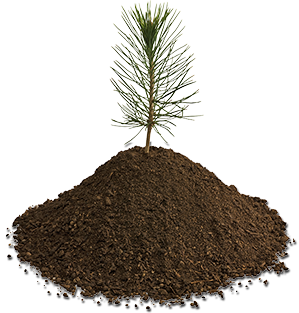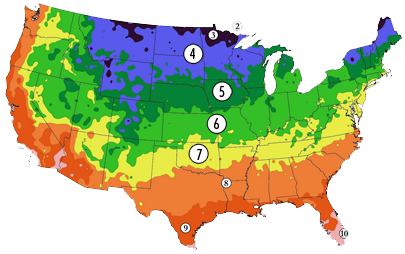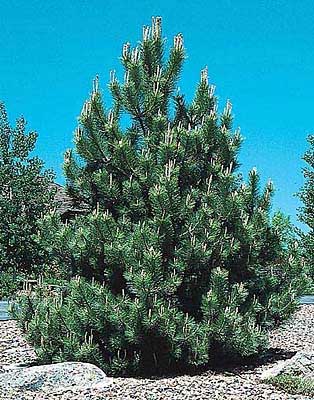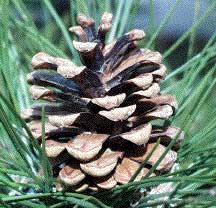
Attributes:
The Austrian Pine is extremely tolerant of adverse soil conditions and air pollution. This stately tree can be seen in parks, along streets, in residential landscapes, and as farm windbreaks throughout much of the United States. Landscapers use the dark beauty of these trees for backdrops, but it is also an excellent specimen tree because of its leaf pattern.

Description:
Very hardy, withstanding city or seaside conditions, heat and drought, and clay and alkaline soils. Good for windbreaks. Grows to 60′ with 20′- 40′ spread (zones 4-7).
Wildlife Value:
Birds and squirrels enjoy Austrian Pine seeds as they do other pine seeds. The large evergreens also provide shelter and nesting sites, particularly for birds such as owls.
History/Lore/Use:The Austrian Pine is a native of Austria, northern Italy and Yugoslavia. It was introduced to the United States in 1759. Its forebears were likely worshipped by the Romans over 2000 years ago. Over 217 million were planted during the nation’s great dust bowl shelterbelt project. It has thrived for over 200 years in some of the worst soil and climate conditions America has to offer.
Moisture:
Normal moisture requirements with some drought tolerance .
.
Leaves:
This tree has spiral, simple, two needles 3 to 6 inches long, dark green.
Flower Color:
Yellow, nondescript.
Bloom Time:
April-May.
Fruit Description:
 The fruit is oval, 1 to 3 inches long, dry, brown.
The fruit is oval, 1 to 3 inches long, dry, brown.
The tree ornament given to our clients in 2011 is handmade from recycled, biodegradable fibers and embedded with seeds. When planted, it will grow into Austrian Pine trees. Simply soak the tree overnight in cold water and then sow 1/4” deep in fine soil, indoors, in a pot (the trees can be transplanted outside in warmer weather after they have established healthy growth). Keep the soil warm and moist until the seeds germinate in approximately three to four weeks. The paper will recycle into the soil and with proper care the seeds will grow into beautiful pine trees.
Treemendous Trivia
- How many gallons of sap does a Sugar Maple Tree produce in a day?
A Sugar Maple tree can produce approximately 3 gallons of sap a day. To make just one quart of maple syrup, it takes 11-13 gallons of sap=’1′
- What tree has the thickest bark?
The tree specie with the thickest bark other than a Redwood is the Coast Douglas Fir tree. On the older trees, the bark can be 8 – 12 inches thick.
- What is the world's slowest growing tree?
White Cedar, located in Canada. After 155 years, it grew to a height of 4 inches and weighed only 6/10th of an ounce. The tree can be found on a cliffside in the Canadian Great Lakes area.
- Where is the world's largest forest?
Northern Siberia, Russia: located between 55 degrees north latitude and the Arctic Circle. It covers a total area of 2.7 billion acres (forty times the land mass of Colorado!).
- What is the world's slowest growing tree?
White Cedar, located in Canada. After 155 years, it grew to a height of 4 inches and weighed only 6/10th of an ounce. The tree can be found on a cliffside in the Canadian Great Lakes area.
- Where did the town of Flagstaff, AZ get its name?
On July 4th 1876, lumberjacks stripped the limbs from the tallest Ponderosa Pine tree and then flew the American flag from it…thus “Flagstaff”.
- How many acorns must an oak tree produce before one actually grows?
- How many species of trees grow in America?
1182. There are about 20,000 tree species in the world. The United States has one of the largest tree treasuries second only to India.
- Where does the most isolated tree in the world live?
On Campbell Island in the Pacific is the most isolated tree on earth. It is a A solitary Norwegian Spruce tree. The next nearest tree to it, is located on the Auckland Islands, over 120 miles away.
- What city in the United States was named after the White Oak?
Albuquerque. New Mexico.
It is named for a Spanish viceroy of New Spain, Francisco Fernandez de la Cueva Enriquez, Duque de Alburquerque y Marques de Cuellar (viceroy from 1701-1711). The story has it that, in 1706, provisional governor Francisco Cuervo y Valdes suggested that the town be named after the viceroy as incentive for the viceroy to grant villa status to the town, which didn’t quite meet villa standards (requiring 30 families to be living in the area; there were only 18 at the time). The governor got what he wanted and the viceroy got his name in lights, as it were. The full, original name of the villa was San Francisco de Alburquerque. Phillip V of Spain apparently did not like that name and changed it to San Felipe de Alburquerque (not a bit narcissistic, that Phillip). The king’s concern with such details didn’t pay off in the end, as the
San Felipe de was dropped from the town’s name (just takes too long to say!).
Today some may tell you that the city was actually named after a famous Portuguese soldier, Afonso de Albuquerque (1453-1515). That is incorrect. Interestingly, the soldier’s name is Spanish in origin and comes from the name of a town in southwestern Spain, Alburquerque (the same place that the viceroy’s dukedom is named after). This word means, literally, “white oak”, coming ultimately from Latin albus “white” and quercus “oak”. There was, as you may have guessed, an abundance of white oak trees in the original Alburquerque, in Spain. And, yes, there is an extra “r” in the Spanish place name. It was dropped in the States, perhaps by influence of the Portuguese soldier’s version of the name, perhaps due to simple elision over time, or, as one legend claims, because a sign painter did not have enough room to include that “r”.
- How many seeds does a mature birch tree produce each year?
A mature birch tree can produce up to 1 million seeds per year.
- What does “dendrochronology ” mean?
Dendrochronology is the science of calculating a tree’s age by its rings.
- How many types of trees are mentioned in the Bible?
There are 36 individual different (going by botanical name) species of trees (listed below) mentioned in the Bible. A few such as Bay and Shittah only appear once while some others like Olive and Palm appear numerous times.
The one passage, Isaiah 41:19 has seven trees mentioned in it. It reads: I will plant in the wilderness the cedar, the shittah tree, and the myrtle, and the oil tree; I will set in the desert the fir tree, and the pine, and the box tree together.
Acacia – {Acacia seyal} – Exodus 37:1, 4, 10, 15, 25, 28
Almond – {Amygdalus communis} – Jeremiah 1:11
Algum/Sandalwood – {Pterocarpus santalinus} – 2 Chronicles 2:8
Almug – {Trerocarpus santalimus} – 1 Kings 10:11
Apple – {Malus communis} – Joel 1:12
Ash – {Fraxinus excelsior} – Isaiah 44:14
Bay – {Laurus Nobilis} – Psalm 37:35
Box – {Buxus sempervirens} – Isaiah 60:13
Bramble/Buckthorn – {Rhamnus purshiana} – Judges 9:14 & 15
Broom – {Cytisus scoparius} – Psalm 120:4
Cedar of Lebanon – {Cedrus libani} – Ezekiel 27:5
Chestnut – {Aesculus hippocastanum} – Genesis 30:37
Citron/Thyine – {Ttetraclinis articulata} – Revelation 18:12
Cypress – {Cupressus macrocarpa} – Isaiah 44:14
Ebony – {Dalbergia melanoxylon} – Ezekiel 27:12 – 24
Elm – {Ulmus campestris} – Hosea 4:13
Fig – {Ficus carica} – Micah 4:4
Fir – {Abies cilicia} – Isaiah 41:19
Hazel – {Corylus avellana} – Genesis 30:37
Juniper – {Juniperus excelsa} – 1 Kings 19:4 & 5
Lign Aloes – {Aquilaria agallocha} – Numbers 24:6
Mulberry – {Morus laevigata} – 2 Samuel 5:23 & 24
Myrtle – {Myrtus communis} – Isaiah 41:19
Oak – {Quercus calliprinos} – Joshua 24:26
Oil/Oleaster – {Elaeagnus angustifolia} – Isaiah 41:19
Olive – {Olea europaea} – Judges 9:8 & 9
Palm, Edible Date Palm {Phoenix dactylifera} – John 12:13
Pine – {Pinus pinea} – 1 Kings 6:14
Plane – {Platanus orientalis} – Ezekiel 31:8
Pomegranate – {Punica granatum} – 1 Samuel 14:2
Poplar – {Populas alba} – Genesis 30:37
Shittah/Setim/Acacia – {Acacia gerrardii} – Isaiah 41:19
Sycamore/Sycomore – {Acer pseudoplatanus} – Luke 19:4
Tamarisk/Tamarix – {Tamarix aphylla} – Genesis 21:33
Teil/Terebinth/Turpentine/Lime – {Tilia cordata} – Isaiah 6:13
Willow – {Salix safsaf} – Ezekiel 17:5


 .
. The fruit is oval, 1 to 3 inches long, dry, brown.
The fruit is oval, 1 to 3 inches long, dry, brown.